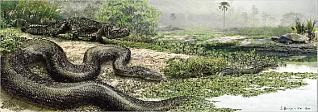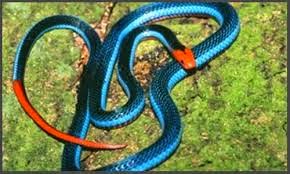When holding a snake, you may notice countless things. Many people notice how smooth the scales are, or that they aren't as slimy as expected. The first thing I noticed, however, was the tightening and relaxing feeling of their muscles. Snakes are practically all ribs and vertebrae, mixed with a ton of muscle, that are closely associated to something called their
ventral scales. These scales are rectangular and layer on the snake's 'belly' or bottom side. If you look at a Corn Snake, these scales are decorated in a black and white checker-board pattern that deviates from the orange-ish yellow-ish scales that cover the rest of the body. Each of the ventral scales align with the ribs of the snake. They act like treads on a tire, causing friction with the ground that allows forward momentum.
 |
| [clearly marked ventral scales on a corn snake] |
There are four basic ways a snake can move:
 |
| [Snake climbing tree using concertina] |
Concertina is a special movement, as it isn't used on a horizontal surface like the other four. Snakes that use concertina are climber snakes. A snake will use its head and front of the body to launch forward on the vertical surface, then grips the surface with those all so important ventral scales. After that, the snake will use the middle part of their body to get a firm hold on the by bunching it up and clings to the surface. Then, the snake just pulls its head back and starts again.
Serpentine is the most recognized movement of a snake, and is often the movement that is thought of when a person says 'slither'. Snakes will move their body in the familiar 'S' shape when performing the serpentine movement. Starting from right behind the head, the snake will contract its strong muscles and move its body from side to side. This is the choice movement for water snakes because it is very useful for propulsion above and below the water. You will also see land snakes who find resistance points on the surface for the ventral scales to get a good grip on. These resistance points can consist of branches, stones, or dents in the ground.
 |
| [water snake using serpentine movement] |
 |
| [Snake sidewinding in the sand] |
Sidewinding is the locomotion used in an environment that has few resistance points. Snakes that use this movement will also switch between sidewinding and serpentine movements depending on their environments. They contract their bodies, like concertina, and launch themselves forward and continue in a side-ways movement. They also leave a 'S' shape in the sand, like the serpentine, but the 'S' will only have two contact points. That is because, most of the snake's body is off the ground when using this locomotion.
The
Caterpillar movement is my favorite out of the four. The slower version of this movement is also called
Rectilinear locomotion. If you've ever seen a caterpillar crawl on a log or on the ground, you will already have the concept of this movement. It basically consists of the snake contracting its body into small curves that go up and down, rather than side to side. The top of the curve is lifted off the ground while the ventral scales on the ground push against the surface. Unfortunately, no picture can truly capture this movement, so a link to a youtube video showing all these movements will be listed below.
Links: http://animals.howstuffworks.com/snakes/snake3.htm
https://www.youtube.com/watch?v=ZSHzDesFe6U












